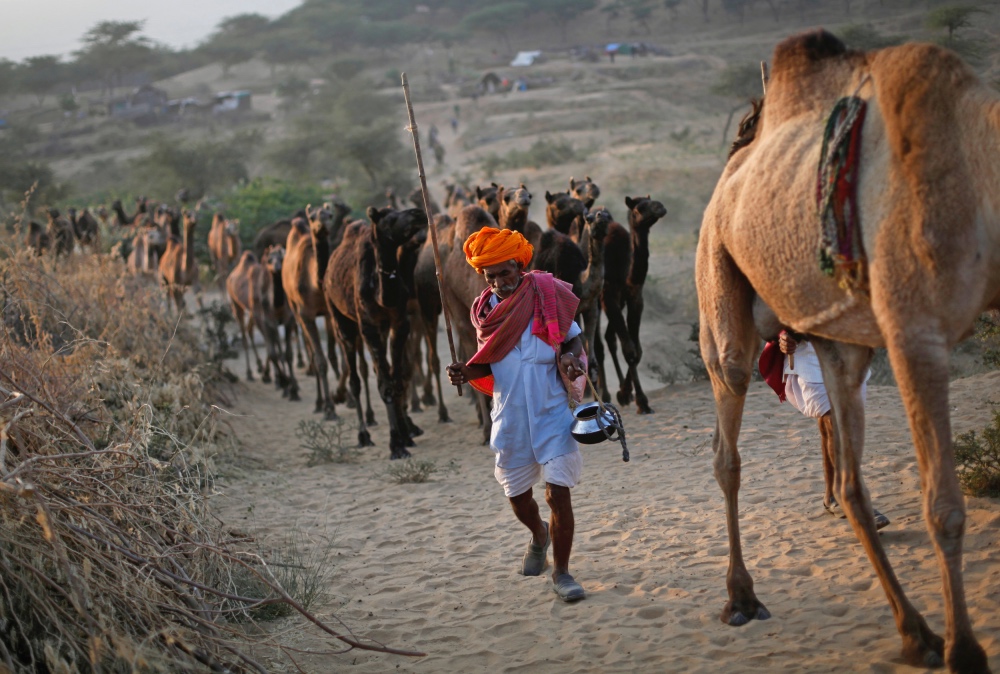Udaipur, India
Thomson Reuters Foundation
South Asian pastoralists facing shrinking rangelands and a rise in conflicts over the right to roam must be allowed greater involvement in managing lands to help secure their survival, land experts said on Thursday.
Herders around the world are coming under pressure from governments to settle down and stop their livestock roaming, as they contend with land conflicts and the impact of climate change such as harsher droughts and desertification.

A camel herder walks his camels at Pushkar Fair in the desert Indian state of Rajasthan on 23rd November, 2012. Many international and domestic tourists throng to Pushkar to witness one of the most colourful and popular fairs in India. Thousands of animals, mainly camels, are brought to the fair to be sold and traded. PICTURE: Reuters/Danish Siddiqui
But in Central Asia, government policies that promote the management of lands by herder communities who roam them have helped secure grazing rights, restore degraded rangeland and reduce conflicts with settled communities, said Hijaba Ykhanbai of the Central Asia Pastoralists’ Alliance.
“The Central Asian model is good for South Asia, as the challenges are the same: climate change, disruption of migration routes, conflicts and threats from mining,” he told a land forum in Udaipur city in India’s Rajasthan state.
“Participatory rangelands management, which is the main trend of reforms in Central Asian countries, can help limit some of these threats.”
In Mongolia, Kyrgyzstan and Tajikistan, rangelands management is largely led by herder communities with help from local authorities, he said, urging other Central Asian countries to adopt similar policies.
In South Asia, Afghanistan is the only country that recognises pastoralism and has policies to protect rangelands, which cover about 45 per cent of the country’s land area, according to the South Asia Pastoralists’ Alliance.
While transnational migration was once common in the region, hardened borders and conflicts over land have forced pastoralists to change their migration routes, said Anu Verma of the Maldhari Rural Action Group (MARAG), a herders’ advocacy.
India alone has an estimated 35 million pastoralists, mostly in the west, in the Himalayan mountain range, and the Deccan Plateau in the south. They are not legally recognised, and receive few state benefits, said Verma.
“The village commons that herders use for grazing are vulnerable to being grabbed by authorities and village elites for industrial use and other commercial purposes,” she said.
“Without a national commons policy, and only a few states having grazing land policies, pastoralists face growing conflicts over land,” she told the Thomson Reuters Foundation.
Pastoralists are an integral part of India’s history, having received royal patronage and welcomed by farmers so their herds of sheep and cattle could graze the crop stubble after the harvest, and fertilise the land.
But with the growing use of chemical fertilisers from the 1960s onwards, their importance diminished and they have increasingly been accused of encroaching the land.
Although their land rights are protected by laws that relate to indigenous people and the 2006 Forest Rights Act, few have been able to claim these rights, as they often lack documentation because of their nomadic status, Verma said.
MARAG and other organisations have been mapping rangelands and pastoralist migration routes in South Asia – which can extend to more than 2,000 kilometres – to help secure herders’ rights and reduce conflicts.
But with warming temperatures sparking more frequent and more severe droughts in South Asia, pastoralists are being forced into new migration routes and to break into smaller groups, which leaves them more vulnerable, Verma said.
“We fear that these growing threats will force them to settle down,” she said.
“Pastoralists are key to protecting the commons and the environment. Yet we are at risk of losing their valuable knowledge and skills.”





